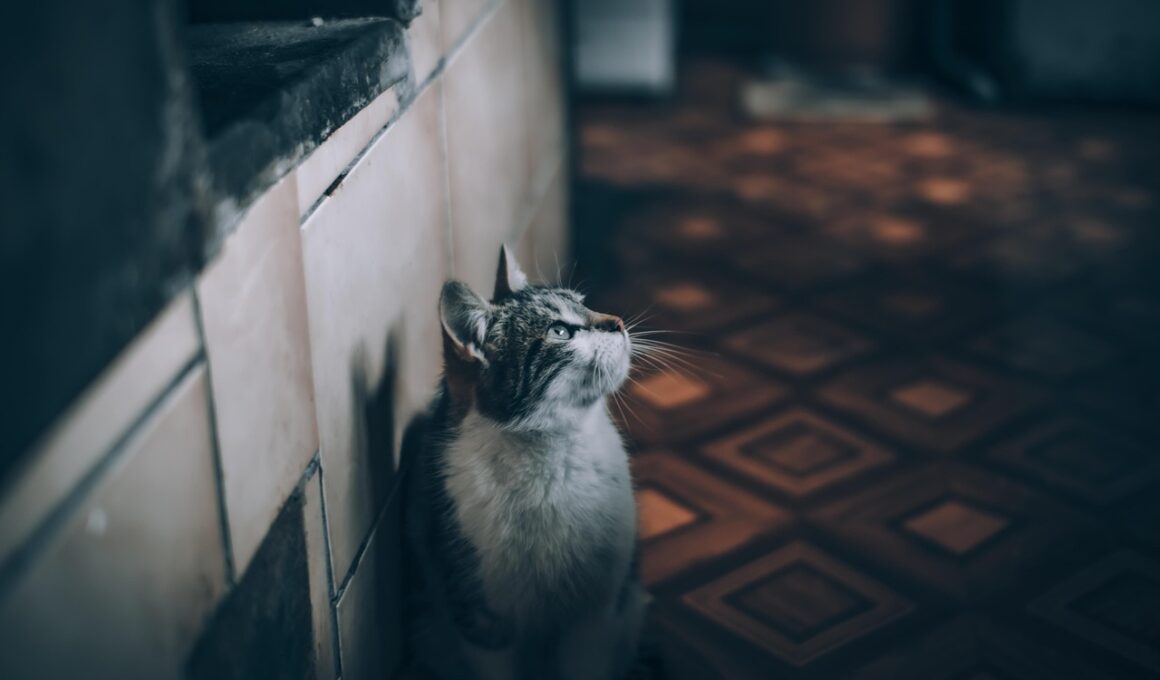Long-Term Health Considerations for Cats After Home Renovations
Home renovations can be thrilling but pose various risks to our furry companions. Cats, in particular, are sensitive creatures with delicate health. Ensuring their safety during renovations requires proactive planning and precautions. The exposure to harmful substances, such as dust and fumes, can lead to respiratory issues. This is especially critical in smaller spaces where air circulation is limited. To mitigate these risks, you should take several steps to protect your feline friend. First, designate a safe space away from the construction area where your cat can relax. This area should be well-ventilated and familiar to your cat. Also, consider using air purifiers to reduce airborne toxins. Additionally, closely supervise their movements throughout the renovation process. It’s vital to ensure that they don’t come into contact with any hazardous materials such as paints or solvents. Educating yourself about the materials used is essential. Always seek products that are labeled as pet-safe. Involving your veterinarian in the conversation can provide valuable insights. They can suggest the best practices to keep your cat healthy and comfortable during this transition.
Another critical consideration is the mental well-being of your cat during home renovations. Cats thrive on routine and stability. Disruptions caused by renovations can lead to stress and anxiety. A stressed cat may exhibit changes in behavior, such as hiding, over-grooming, or even aggression. To alleviate this, provide your cat with their favorite toys and blankets in their designated safe space. Ensure that they have access to their litter box, food, and water without interruptions. Maintaining a consistent feeding schedule also aids in providing a sense of normalcy for your cat. Moreover, consider engaging your cat with interactive play. This can be a great distraction from the ongoing noise and unfamiliar activity around them. Furthermore, pheromone diffusers and calming sprays can help reduce anxiety during this time. These products create a soothing environment that can help your feline friend adapt to the chaos of renovations. After renovations are completed, gradually reintroduce your cat to the renovated spaces. Monitor their reactions closely during this transition. This approach ensures a smoother and healthier recovery for your pet in the long run.
Potential Health Issues Post-Renovation
Post-renovation, it’s essential to be aware of any potential health issues that may arise. The renovation process might leave behind harmful residues or materials that can affect your cat’s health. Common symptoms to watch for include allergic reactions, respiratory distress, or gastrointestinal problems. These symptoms can arise from exposure to dust, mold, or even paints and adhesives that were used during remodeling. To ensure your cat’s well-being, it’s advisable to conduct a thorough cleaning once renovations are complete. Vacuum carpets, and upholstery and wash any bedding your cat frequently uses. Additionally, consider using eco-friendly, non-toxic cleaning products to avoid introducing further chemicals into your home environment. Bringing your cat for a post-renovation check-up with the veterinarian is wise. They can perform a health evaluation to rule out any adverse effects caused by the renovation. Also, consider keeping your cat indoors for a few days after completion, to minimize exposure to any potentially harmful elements outside. By staying vigilant and proactive, you can help ensure your cat remains healthy and happy post-renovation.
Another aspect to consider is the changes in the physical environment after renovations. New flooring, furniture, or even paint can change the dynamics of a home. For some cats, this can be quite overwhelming as they adjust to unfamiliar smells and objects. Different flooring materials can impact their comfort levels. For instance, cats are used to the texture of carpets or rugs and may find hard surfaces uncomfortable for their paws. To ease this transition, slowly introduce your cat to new areas of your home. Allow them to explore at their own pace and ensure they have safe escape routes to retreat. Also, if possible, use familiar scents, like rubbing their existing bedding on new furniture or surfaces, to create a homey atmosphere. Providing several safe vertical spaces, such as cat trees or shelves, can give your cat safe observation points to survey their new environment. Ensure that any new furniture is stable to prevent accidents. With these considerations in mind, you can help your cat feel secure and adapt successfully to their newly renovated home.
Long-Term Adjustment
Long-term health considerations for your cat can extend beyond the immediate aftermath of renovations. As you and your cat settle into the changed environment, ongoing adjustments are necessary. Regularly assess your cat’s behavior and health in your newly renovated spaces. Look out for changes in appetite, activity levels, or overall demeanor to ensure they are feeling secure. If you notice significant changes, consult with your veterinarian as these could reflect deeper underlying issues. Additionally, keep an eye on any developing allergies. Sometimes, materials used during renovations may contribute to long-term health effects. Cats can develop sensitivities to new substances, causing skin irritations or respiratory problems. Providing a balanced diet supplemented with veterinarians’ recommended nutrients can help bolster your cat’s overall health. Staying proactive about your cat’s well-being is essential. Regular veterinary check-ups will help track your pet’s health over time. Early intervention can prevent potential long-term issues resulting from exposure to harmful substances or stressors that came about during renovations. Ultimately, prioritizing your cat’s health in the long run will lead to a happy and thriving feline.
In summary, prioritizing your cat’s safety and well-being during home renovations is vital for their long-term health. By taking proactive steps to secure their environment, you can help mitigate potential risks. Educating yourself about harmful substances, maintaining a consistent routine, and providing safe spaces will create a healthier atmosphere for your cat. Post-renovation considerations are equally significant, as keeping your home clean and free from residual toxins ensures your cat’s continues to thrive in their surroundings. Furthermore, understanding how to address your cat’s mental and emotional needs presents a holistic approach to their care. Your relationship with your cat will also flourish as you demonstrate your commitment to their health. Building a safer environment can ease their anxiety, reduce stress levels, and promote overall happiness. As you navigate the renovation process, staying attuned to your cat’s responses will enhance their quality of life significantly. Ultimately, your effort and diligence will pay off, leading to a smoother transition back into their new home. Pets are a part of our family, and ensuring their safety during changes like home renovations is an essential responsibility to uphold.
Finally, take note of your cat’s play and behavior patterns in the wake of renovations. Cats are creatures of habit, and changes in their territory can influence their activities. Creatively engaging your cat through various activities can also encourage a normalized adjustment period. This could include utilizing catnip toys, interactive puzzle feeders, or engaging in redirecting play when they become overwhelmed. Such activities can transform a potentially stressful situation into an engaging one and encourage positive behaviors. Also consider enriching their environment with climbing structures or scratching posts which can provide additional stimulation. If your cat displays signs of excessive stress or fear, professional guidance from an animal behaviorist can be beneficial. They can offer tailored advice to specifically address post-renovation issues. Enriching your cat’s life promotes their confidence and comfort, empowering them to reclaim their space. Your home can become a nurturing haven that adapts to both your lifestyle and that of your beloved pet. As you create a safe and inviting atmosphere, your cat’s health and happiness should be paramount in your mind throughout and after any home renovation.
Conclusion
In conclusion, long-term health considerations for cats after home renovations are vital. Awareness of the dangers and careful planning is critical to keeping your cat safe and sound. Following the guidelines provided, you can ensure your renovation journey results in a safe and comfortable home for your feline friend. Always prioritize their safety and monitor their health, providing them with love and security in their renovated environment. Through thoughtful actions, you ensure a happy and healthy life for your pet, harmonizing your home and feline friend seamlessly. The effort devoted to understanding your cat’s needs during renovations will foster a supportive environment, cementing your bond with them. Ultimately, a happy home environment benefits not only your cat but all members of your household. Always pay attention to your cat’s responses, adjusting your approach as necessary. With the right precautions, your cat can thrive in their newly adapted space. A smooth transition rests on continued efforts to understand and support their unique needs. Dedicating time and love to your cat ensures a harmonious and happy life for years to come.


